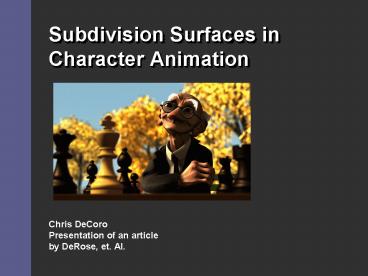Subdivision Surfaces in Character Animation - PowerPoint PPT Presentation
1 / 18
Title:
Subdivision Surfaces in Character Animation
Description:
Semi-sharp Creases. An adjustable intermediate between smooth surfaces and ... Most 'sharp' edges in nature are smooth at a sufficiently close distance ... – PowerPoint PPT presentation
Number of Views:81
Avg rating:3.0/5.0
Title: Subdivision Surfaces in Character Animation
1
Subdivision Surfaces in Character Animation
Chris DeCoro Presentation of an article by
DeRose, et. Al.
2
Talk outline
- Introduction
- Motivation and applications
- Previous work
- Additional requirements of animation
- Semi-sharp Creases
- Rendering
- Physically-based Modeling
- Conclusion
3
Motivation and Background
- Animation requires smooth surfaces for visual
appeal - Traditional Approach NURBS
- However, single patches have limited topology
- Difficult to maintain smoothness during animation
- Often require expensive and inaccurate trimming
- Proposed Solution Subdivision Surfaces
- Able to represent arbitrary topology
- No trimming
- No seams always smooth
4
Previous work
- Catmull-Clark Subdivision
- Input is a quadrilateral mesh, M0
- From mesh Mn, reaches Mn1 through subdivision
- Adds additional vertices to make each quad into 4
subdivided quads - Limit surface (infinite subdivisions) is smooth
- Infinitely-sharp Creases
- In some locations, the ideal surface is not
smooth - For these applications, we require creases
- Sharp edges are manually marked as such
- Algorithm uses special subdivision rules
5
Additional requirements of animation
- Semi-sharp Creases
- An adjustable intermediate between smooth
surfaces and infinitely sharp creases - Physical Modeling
- Surfaces pose challenges in representing real
world movement and collisions - The article will focus on physical modeling of
cloth - Rendering
- NURBS have a direct parameterization for texture
mapping - Subdivision surfaces do not
6
Talk outline
- Introduction
- Semi-sharp Creases
- The need for Semi-sharp Creases
- Standard Subdivision
- Infinitely-sharp Creases
- Overall Algorithm
- Rendering
- Physically-based Modeling
- Conclusion
7
The Need for Semi-sharp Creases
- Most sharp edges in nature are smooth at a
sufficiently close distance - E.g. the edge of a table top
- Often we wish to control the degree of sharpness
- Shown in the illustrations below
8
Standard Subdivision
- Standard Catmull-Clark Subdivision has three
types of points in each refined mesh - Face points
- Vertex points
- Edge points
- Face points centroid of each quad region
- Edge points 0.25(vi ei fJ-1 fJ )
- Vertex points (n-2)/nvi 1/n2sum(ei)
1/n2sum(fi1)
9
(No Transcript)
10
Infinitely-Sharp Creases
- Control vertices and edges are manually tagged as
sharp - Face points same as smooth rule
- Edge points place at midpoint of edge
- Vertex points
- One sharp incident edge (dart) same as smooth
rule - Two sharp edges (crease) (e1 6vi e2) / 8
- Three or more sharp edges (corner) do not modify
point
11
Overall Algorithm
- For creases with integer sharpness s
- Subdivide using infinitely-sharp rules s times
- For creases with non-integer sharpness s
- Assume creases with sharpness floor(s) and
ceil(s) - Determine subdivision points for both cases
- Linearly interpolate to compute points for s
- After previous steps, and for all elements
- Perform standard (smooth) subdivision to the
limit
12
Talk outline
- Introduction
- Semi-sharp Creases
- Rendering
- Surface texture mapping
- Implementation issues
- Physically-based Modeling
- Conclusion
13
Texture Mapping
- Textures parameterized onto a 2d plane
- Ideal for NURBS
- Not so ideal for Subdivision Surfaces
- Solution Subdivide texture coordinates
- Manually apply texture coordinates to the base
mesh - Treat vertex as (x,y,z,s,t) five-tuple
- The texture coordinates are subdivided along with
the coordinates - Can be applied to arbitrary attributes
- Normals, arbitrary shader parameters
14
Implementation Issues
- The author is working with the Pixar RenderMan
system - Requires geometry be subdivided to sub-pixel
sized micropolygons - Each primitive must bound itself, dice into
micropolygons - Bounding takes advantage of convex hull property
- Each primitive must dice itself into
micropolygons - Locally, surface represents bicubic B-spline
patch - Surface is converted into patch, uses less space
(4x4 grid) - Regular structure makes easier to dice into
micropolygons
15
Talk outline
- Introduction
- Semi-sharp Creases
- Rendering
- Physically-based Modeling
- Computing cloth energy functional
- Collision determination
- Conclusion
16
Determining Energy Functional
- Basic properties are specified by energy
functional - Represents attraction or resistance of material
to deformation - Catmull-Clark methods become regular grids
- Ideal for representing woven fabrics
- Energy term represented by
- E(p1,p2) 0.5(p1-p2/p1-p2)2
- p1, p2 are the positions at rest
- This can be used to represent the motion of cloth
- Limited motion along thread directions
- Folds freely along the diagonals
17
Collision Determination
- Several approaches stand out
- Test every object against each other
(impractical) - Three-D spatial partitioning (not ideal)
- Two-D surface partitioning
- Advantages of surface partitioning
- Hierarchy fixed if connectivity does not change
- All data statically allocated, compute in
preprocess - Hierarchy generation through un-subdividing
- Pick a candidate edge e
- Remove faces adjacent to e, merge to
super-face - Mark edges adjacent to super-face as
non-candidates for one iteration (for better
balancing) - Store bounding box
- At run time, use precomputed hierarchy to compare
bounding boxes between object and obstacles
18
Conclusion
- Subdivision surfaces are a better alternative to
NURBS - Always smooth, no seams
- No trimming, greater range of topology
- Semi-sharp Creases allow for enhanced control
- Sharpness can range smooth from none to infinite
- Scalar-field texture maps allow for simplified
texturing - Directly generated from the base mesh
- Successfully integrated into RenderMan
- Thus has shown to be successful in real-world
applications - Collision detection model / Energy functional
- Allows for realistic physics































